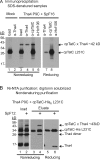Substrate-gated docking of pore subunit Tha4 in the TatC cavity initiates Tat translocase assembly
- PMID: 24711501
- PMCID: PMC3987133
- DOI: 10.1083/jcb.201311057
Substrate-gated docking of pore subunit Tha4 in the TatC cavity initiates Tat translocase assembly
Abstract
The twin-arginine translocase (Tat) transports folded proteins across tightly sealed membranes. cpTatC is the core component of the thylakoid translocase and coordinates transport through interactions with the substrate signal peptide and other Tat components, notably the Tha4 pore-forming component. Here, Cys-Cys matching mapped Tha4 contact sites on cpTatC and assessed the role of signal peptide binding on Tha4 assembly with the cpTatC-Hcf106 receptor complex. Tha4 made contact with a peripheral cpTatC site in nonstimulated membranes. In the translocase, Tha4 made an additional contact within the cup-shaped cavity of cpTatC that likely seeds Tha4 polymerization to form the pore. Substrate binding triggers assembly of Tha4 onto the interior site. We provide evidence that the substrate signal peptide inserts between cpTatC subunits arranged in a manner that conceivably forms an enclosed chamber. The location of the inserted signal peptide and the Tha4-cpTatC contact data suggest a model for signal peptide-gated Tha4 entry into the chamber to form the translocase.
Figures








Similar articles
-
Mapping the signal peptide binding and oligomer contact sites of the core subunit of the pea twin arginine protein translocase.Plant Cell. 2013 Mar;25(3):999-1015. doi: 10.1105/tpc.112.107409. Epub 2013 Mar 19. Plant Cell. 2013. PMID: 23512851 Free PMC article.
-
Oligomers of Tha4 organize at the thylakoid Tat translocase during protein transport.J Biol Chem. 2006 Mar 3;281(9):5476-83. doi: 10.1074/jbc.M512453200. Epub 2005 Dec 30. J Biol Chem. 2006. PMID: 16407186
-
The chloroplast twin arginine transport (Tat) component, Tha4, undergoes conformational changes leading to Tat protein transport.J Biol Chem. 2012 Oct 5;287(41):34752-63. doi: 10.1074/jbc.M112.385666. Epub 2012 Aug 15. J Biol Chem. 2012. PMID: 22896708 Free PMC article.
-
Mechanistic Aspects of Folded Protein Transport by the Twin Arginine Translocase (Tat).J Biol Chem. 2015 Jul 3;290(27):16530-8. doi: 10.1074/jbc.R114.626820. Epub 2015 May 14. J Biol Chem. 2015. PMID: 25975269 Free PMC article. Review.
-
The Tat pathway in bacteria and chloroplasts (review).Mol Membr Biol. 2005 Jan-Apr;22(1-2):113-21. doi: 10.1080/09687860500041809. Mol Membr Biol. 2005. PMID: 16092529 Review.
Cited by
-
New insights into the Tat protein transport cycle from characterizing the assembled Tat translocon.Mol Microbiol. 2022 Dec;118(6):637-651. doi: 10.1111/mmi.14984. Epub 2022 Oct 5. Mol Microbiol. 2022. PMID: 36151601 Free PMC article.
-
Influence of the TorD signal peptide chaperone on Tat-dependent protein translocation.PLoS One. 2021 Sep 9;16(9):e0256715. doi: 10.1371/journal.pone.0256715. eCollection 2021. PLoS One. 2021. PMID: 34499687 Free PMC article.
-
A larger TatBC complex associates with TatA clusters for transport of folded proteins across the bacterial cytoplasmic membrane.Sci Rep. 2024 Jun 14;14(1):13754. doi: 10.1038/s41598-024-64547-x. Sci Rep. 2024. PMID: 38877109 Free PMC article.
-
High Throughput Screen for Escherichia coli Twin Arginine Translocation (Tat) Inhibitors.PLoS One. 2016 Feb 22;11(2):e0149659. doi: 10.1371/journal.pone.0149659. eCollection 2016. PLoS One. 2016. PMID: 26901445 Free PMC article.
-
Substrate-triggered position switching of TatA and TatB during Tat transport in Escherichia coli.Open Biol. 2017 Aug;7(8):170091. doi: 10.1098/rsob.170091. Open Biol. 2017. PMID: 28814647 Free PMC article.
References
Publication types
MeSH terms
Substances
Grants and funding
LinkOut - more resources
Full Text Sources
Other Literature Sources

